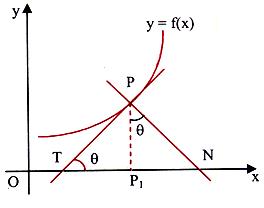Tangent and Normal to a Curve
Table of Content |
Geometrical Meaning of the Derivative
 The tangent to the curve y = f(x) at the point (x, y) makes an angle y with the positive x-axis. Then dy/dx = tan Ψ. Thus the derivative dy/dx or f'(x) represents the slope of the tangent to the curve at the point (x, y).
The tangent to the curve y = f(x) at the point (x, y) makes an angle y with the positive x-axis. Then dy/dx = tan Ψ. Thus the derivative dy/dx or f'(x) represents the slope of the tangent to the curve at the point (x, y).
Tangent and Normal to a Curve
Having talked at length about (dy/dx)(x=a), which gives us the slope at any point of curve, the first thing which strikes an aspirant's mind is it's use to find the equation of tangent or normal of the curve at any point on the curve since dy/dx at x = a gives the slope of tangent at any point x = a of a curve y = f(x), so we can put the value of x = a in f(x) and find the corresponding value of y.
The equation of tangent to the curve y = f(x) at point (a, f(a)) is (y - f(a)) = (dy/dx)(x=a) (x - a) and
Equation of normal is
y - f(a) = 1/(dy/dx)(x=a) (x - a)
Provided (dy/dx)|(x=a) ≠ 0
Let us take another curve for explanation.
PT is the tangent to the curve y = f(x) at the point P(x1, y1).
PN is the normal to the curve at P.
The slope of the tangent at P(x1, y1) is, [dy/dx](x1,y1).
The slope of the normal at P(x1, y1) is, 1/[dy/dx](x1,y1).
Hence the equation of the tangent PT is, y - y1 = [dy/dx](x1,y1) (x - x1),
and the equation of the normal PN is, y - y1 = 1/[dy/dx](x1,y1) (x - x1)
or, [dy/dx](x1,y1) = 0.
If (dy/dx)(x1,y1) = 0, then the equation of the normal would be x = x1.
If the equation of the curve is in the parametric form x = f(t) and y g(t),
Then dy/dx=dy/dt/dx/dt=(g' (t))/(f' (t)).
Thus the equations of the tangent and the normal are
y - g(t) = (g' (t))/(f' (t)) (x - f(t))
and f'(t)[x - f(t)] + g'(t)[y - g(t)] = 0.
Length of Tangent and Normal
Let P(x, y) be any point on y = f(x). Let the tangent drawn at 'P' meet the
x-axis at 'T', and normal drawn at 'P' meets the x-axis at 'N'. PT is called the length of the tangent and PN is called the length of the normal.
If 'P1' be the projection of the point P on the x-axis then TP1 is called the sub-tangent (projection of line segment PT on the x-axis) and NP1 is called the sub normal (projection of line segment PN on the x-axis).
Let ∠PTN = q => ∠ P1PN = q.
We have tan q = dy/dx and PP1 = y.
Now, PT = y cosec q or,
PT = y√(1+ cot2 θ )=y√(1+(dx/dy)2 ).
Also, PN = y sec q = y√(1+tan2 θ )=y√(1+(dy/dx)2 ).
=> Length of the normal, PN = |y| √(1+(dy/dx)2 ).
To read more, Buy study materials of Applications of Derivatives comprising study notes, revision notes, video lectures, previous year solved questions etc. Also browse for more study materials on Mathematics here.
View courses by askIITians


Design classes One-on-One in your own way with Top IITians/Medical Professionals
Click Here Know More

Complete Self Study Package designed by Industry Leading Experts
Click Here Know More

Live 1-1 coding classes to unleash the Creator in your Child
Click Here Know More

a Complete All-in-One Study package Fully Loaded inside a Tablet!
Click Here Know MoreAsk a Doubt
Get your questions answered by the expert for free



